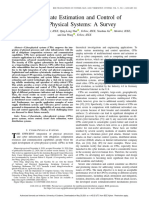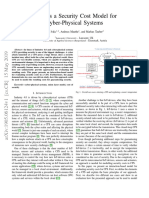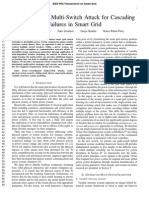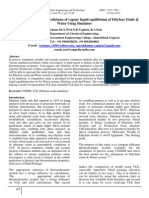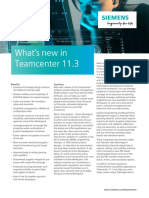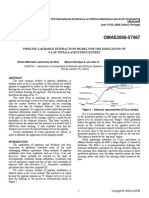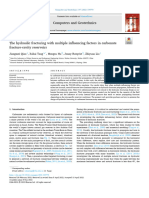Implementing A Real-Time Cyber-Physical System Test Bed in RTDS and OPNET
Implementing A Real-Time Cyber-Physical System Test Bed in RTDS and OPNET
Uploaded by
Bo ChenCopyright:
Available Formats
Implementing A Real-Time Cyber-Physical System Test Bed in RTDS and OPNET
Implementing A Real-Time Cyber-Physical System Test Bed in RTDS and OPNET
Uploaded by
Bo ChenOriginal Description:
Original Title
Copyright
Available Formats
Share this document
Did you find this document useful?
Is this content inappropriate?
Copyright:
Available Formats
Implementing A Real-Time Cyber-Physical System Test Bed in RTDS and OPNET
Implementing A Real-Time Cyber-Physical System Test Bed in RTDS and OPNET
Uploaded by
Bo ChenCopyright:
Available Formats
Implementing a Real-Time Cyber-Physical System
Test Bed in RTDS and OPNET
Bo Chen, Karen L. Butler-Purry
Department of Electrical and
Computer Engineering
Ana Goulart
Department of Engineering
Technology and Industrial Distribution
Texas A&M University
College Station, TX, USA
{bchen, klbutler}@tamu.edu
Texas A&M University
College Station, TX, USA
goulart@tamu.edu
AbstractNumerous innovative smart grid technologies are
deployed in modern power systems, making a power system a
typical cyber-physical system (CPS). The increasing coupling
between a physical power system and its communication
network requires a smart grid simulator to run in a cyberphysical environment for cyber security research. In addition,
smart grid technologies introduce numerous access points to the
communication network, making cyber security a big concern in
smart grid planning and operation. In this paper, a simple real
time CPS test bed, implemented in RTDS and OPNET, is
discussed. The setup of the test bed is introduced. Results of a
case study simulated in the test bed to study the impact of cyber
attacks on system transient stability are presented. The simple
test bed was capable of accurately modelling a smart grid while
providing user-friendly modeling experience.
Index Termscyber-physical system, test bed, cyber security,
smart grid, cyber attack, real time simulation, RTDS, OPNET
I.
INTRODUCTION
Numerous innovative smart grid (SG) technologies are
increasingly deployed in modern power systems.
Implementation of smart grid applications requires advanced
communication technologies, making a power system a typical
cyber-physical system [1]. Smart grid technologies facilitate
power system planning and operations, improve system
stability and reliability, and offer integration of distributed
energy resources (DER) such as wind, solar and biomass [2].
Most smart grid technologies enable bidirectional data
communications, hence potentially introduce cyber security
issues. Numerous access points that are distributed over the
smart grid become possible victims that can be compromised
by potential cyber attacks [3]. The cyber security issues not
only include deliberate attacks launched by corrupted
employees, agents of industrial espionage, customers with
hacker skills, terrorists, and other agents for benefit or political
purposes, but also induced by unintentional threats such as
operational error, data error, communication delay, equipment
failures and natural disasters [4]. Recent research has shown
that an intentional cyber attack can cause significant impact on
power systems in terms of stability and economical operation
[5, 6]. Therefore, cyber security of smart grid is a big security
concern that is getting more and more attention along with
This work was supported in part by Norman Hackerman Advanced Research
Program Project 000512-0111-2009 and NSF grants EECS-1028246 and
EEC-1062603.
Deepa Kundur
Department of Electrical and
Computer Engineering
University of Toronto
Toronto, ON, Canada
dkundur@comm.utoronto.ca
deployment of smart grid applications
To address the cybersecurity issues of smart grids,
research focusing on different aspects of cybersecurity has
been conducted. A framework was proposed in [7] for cyber
attack impact analysis. Potential vulnerabilities were identified
in [8, 9]. Several cyber attacks and their impact on smart grids
were studied in [6, 10], and corresponding mitigation
strategies were investigated in [11, 12]. However, current
efforts to address cyber security issues are constrained by the
availability of a cyber-physical test bed. To achieve cyber
security resiliency, a test bed that can simulate realistic cyberphysical environments is needed to evaluate the cyber attacks
and verify the proposed mitigation strategies [13].
Several CPS test beds have been developed in [14-18]. In
[14], a test bed was developed for SCADA cyber security.
PowerWorld was used for simulating physical power systems.
A real time immersive network simulation environment
(RINSE) was integrated with PowerWorld to emulate realistic
networks as well as cyber attacks and defenses. In [15], a
hybrid test bed was developed by combining hardware
(computers, routers, switches, firewalls, etc.) and software
(OPNET). The system-in-the-loop (SITL) feature of OPNET
was used to bridge hardware and software, making the test bed
reconfigurable. To detect the cyber attacks on SCADA,
authors in [16] developed a test bed with PowerWorld and
OPNET. However, these test beds cannot run in real time or
perform hardware-in-the-loop (HIL) simulation. A real time
test bed was developed in [17] with the real time digital
simulator (RTDS) and network analyzer, which can simulate
denial of service (DoS) attacks. Authors in [18] developed a
cyber-physical security test bed using RTDS, DIgSILENT and
the internet-scale event and attack generation environment
(ISEAGE). Three types of cyber attacks were performed and
the impact was evaluated.
In this paper, a real time cyber-physical test bed,
developed in RTDS and OPNET, is discussed. The HIL and
SITL capacities of the test bed allow implementation of a
combination of hardware, software, emulators and other
intelligent electronic devices (IEDs).
The remainder of this paper is organized as follows.
Section II reviews cyber security issues and requirements for a
CPS test bed. Section III introduces the proposed real time
cyber-physical test bed. A case study is presented in section
IV, and the impact of man-in-the-middle attack on power
system is discussed. Finally, conclusions and future work are
discussed in section V.
II.
TEST BED FOR CYBER-PHYSICAL SMART GRID
Smart grid is a typical cyber-physical system due to the
tight coupling between information and communication
technologies (ICT) and physical power systems. The cyberphysical security of smart grid should be investigated to
guarantee the grids resilience. A CPS test bed is needed to
conduct the cyber security research.
A. Cyber-Physical Security for the Smart Grid
Cyber security of smart grid is becoming increasingly
important due to the adoption of smart grid technologies. U. S.
Department of Energy (DOE) has identified cyber security as
a primary requirement for enhancing the security and
reliability of the next generation grid [19]. The widely
deployed smart grid technologies, such as wide area
monitoring
system
(WAMS),
advanced
metering
infrastructure (AMI), demand response (DR) and microgrid,
are implemented based on bi-directional data communication
[20]. Measurement data, control commands, electricity price
signals and other types of data are transmitted between control
centers and end users through an interconnected
communication network. On one hand, these technologies
greatly facilitate smart grid in terms of reliability, stability and
economic operation. On the other hand, cyber security issues
are introduced inevitably, due to numerous accessing points
that are exposed to potential hazards. An attacker with
knowledge of communication, networking and power system
can easily launch cyber attacks.
B. Need for a Cyber-Physical Test Bed
Traditional software can only simulate or emulate
communication networks (e.g. OPNET, NS2, OMNET) or
physical power systems (e.g. RTDS, DSATools, PSS/E,
PowerWorld). These software cannot provide a realistic cyberphysical environment to study the characteristics of cyberphysical system. It can be expected that any attacks on either
the cyber part or the physical part will definitely impact the
other part. For example, a denial of service (DoS) attack can
flood a communication node, induce network delay, slow
network performance, or even make the network unavailable
to perform intended functionalities. If a voltage regulator is
compromised by DoS attacks, its controller will act
abnormally and cause degradation of performance [21]. On
the other hand, changes of a physical system will influence
network performance since the physical system determines the
data transmitted through the network and energizes network
devices such as data servers, routers, switches, transmitters
and antennas. Therefore, to investigate the cyber security of
smart grid, a CPS test bed is needed to precisely model a
cyber-physical smart grid.
C. CPS Test Bed Capabilities and Applications
A CPS test bed needs certain capabilities to support cyber
security research. Figure 1 shows four critical capabilities of a
CPS test bed to implement the test bed applications that are
specified in [18].
Figure 1. CPS test bed capabilities and applications
1) Cyber-physical security simulation: This is a basic
capability of the proposed test bed. A CPS test bed is
supposed to not only simulate a power system and its
networking system simultaneously, but also simulate most
types of cyber attacks and physical contingencies that are
normally encountered in the real world. This enables
researchers to do impact analysis and vulnerability evaluation.
2) Data virtualization: A CPS test bed should be able to
derive the interested data easily. Data virtualization allows
researchers to get an idea of what is going on at each step
during simulation. This is important since it is the only way
that the impact of cyber attacks can be used to observe, or
evaluate the performance of mitigation strategies.
3) Interoperability[18]: To evaluate the performance of
intelligent electronic devices (IED) in the context of cyberphysical smart grids, a CPS test bed should be able to connect
to external hardware to perform the hardware-in-the-loop
(HIL) simulation and system-in-the-loop (SITL) simulation.
Also, the test bed should be able to run in real time to provide
realistic data to drive IEDs.
4) Scalability: Scalability refers to the ability of
configuring topology for both a cyber system and a physical
system. This is useful when researchers try to study the
impact of cyber attacks on different power systems with same
communication network, or the same power system with
different types of communication networks.
Four main test bed applications shown in Figure 1 are
introduced below.
1) Impact analysis[18]: The proposed test bed should be
able to analyze the impact of potential cyber attacks on power
system in terms of reliability, stability and economic
operation. The impact analysis helps researchers have a clear
sense of potential hazards when the system is subjected to
cyber attacks and physical hazards.
2) Vulnerability evaluation[18]: A security vulnerability
is a weakness that can be utilized by potential attackers to
compromise the integrity, availability, or confidentiality of
the system [7]. Smart grid incorporates numerous hardware
and software with potential vulnerabilities in the protocols
and communication media. Vulnerability evaluation is to
detect the deficient that exists in a communication network.
The test bed should allow researchers to perform different
strategies to evaluate possible vulnerabilities.
3) Mitigation Evaluation[18]: Researchers need to test the
proposed mitigation strategies. A CPS test bed should be able
to implement the proposed mitigation strategies and provide
data virtualization to generate a verification report. For
example, to mitigate a DoS attack, researchers may propose a
reconfiguration method to isolate or limit the bandwidth of
the compromised channel. The test bed is supposed to
implement the proposed mitigation method by configuring
the network accordingly and providing data visualization
such as real time traffic monitoring.
4) Training and education[18]: A CPS test bed should not
only virtualize the cyber data and the physical data, but also
be able to receive the control commands from system
operators to mitigate the potential threats. In addition, userfriendly modeling experience and data virtualization will
make a test bed suitable for educational purposes.
III.
PROPOSED REAL TIME CYBER-PHYSICAL TEST BED
Physical System Modeler
Cyber System Modeler
Power System Controllers
Control Center & Substations
(implemented in RTDS)
(implemented in third party simulator)
Control commandsMeasurement data
Power System
(implemented in RTDS)
Measurement dataControl commands
Physical IEDs
Data
Exchange
Socket
Control/dispatch commentsPackets
Communication
Network
(implemented in OPNET)
Packets
Packets
Physical Networking Devices
Figure 2. Architecture of the proposed cyber-physical system test bed
should be done in real time. The blocks in Figure 2 are
introduced below.
1) Physical System Modeler: Physical system modeler
comprises a power system modeler and corresponding
controllers, as well as physical IEDs. The power system
modeler (RTDS) includes all the modeling components that
represent a physical system, such as generators, transformers,
lines and loads. The controllers (e.g. exciter, governor)
collect the measurement data from the power system model
and send control commands. Similarly, a physical IED (e.g.
A. Test Bed Elements
The real time digital simulator (RTDS) is used to simulate protective relay, PMU) can also exchange needed data with
a power system and perform analogue/digital input/output the power system model and the controller. The data can
(I/O). The OPNET Modeler is used to simulate either be exchanged within the physical system modeler, or
communication networks, generate traffic, and launch cyber be exchanged through the cyber system modeler, depending
attacks. The National Instruments LabVIEW PXI platform [22] on whether a controller or a control IED is connected to the
with field-programmable gate array (FPGA) bridges OPNET communication network. RTDS can easily model a power
and RTDS while providing supplemental data virtualization.
system and its controllers using its user interface software
1) RTDS: Real time digital simulator (RTDS) is RSCAD. The GTNET card, as well as the GT-AI/O card and
specifically designed for simulating power systems and GT-DI/O card, enables RTDS to communicate with the cyber
testing physical IEDs with high accuracy [23]. Various I/O system modeler through ethernet or analogue/digital I/O ports.
2) Cyber System Modeler: Cyber system modeler
cards with numerous analogue and digital channels enable the
HIL feature to be implemented easily. Furthermore, the (OPNET) can interact with physical system modeler by
GTNET card supports various protocols (GSE, SV, DNP) simulating a reconfigurable communication network. The
control center and the substation networks can be modeled in
based on the data format defined in IEC 61850 standards.
2) OPNET Modeler: The OPNET modeler can simulate a the cyber system modeler. Physical networking devices
complicated networking environment that supports various enable the interaction between a virtual communication
industrial protocols and technologies [24]. The system-in-the- network and a physical communication network. Smart grid
loop (SITL) feature enables researchers to evaluate the applications in control centers and substations are
performance of a network that is comprised of virtual implemented in third party software. The SITL feature
network and physical networking devices in real time. Rich enables OPNET software to interact with external network
visualization and user-friendly operability make models interfaces (e.g. PC, switch, router, server).
3) Data Exchange Socket: Data exchange socket enables
developed in OPNET easy to understand, thus suitable for
data to be exchanged between the cyber system modeler and
training and education.
3) LabVIEW Real-Time Module: To bridge RTDS and the physical system modeler. The analogue and the digital
OPNET in real time, the LabVIEW PXI platform acts as a signals generated by GT-AI/O and GT-DI/O cards are
converted into packets that transferable in the cyber system
mediator in the proposed test bed.
modeler. On the other hand, the packets will be parsed and
B. Test Bed Architecture
converted to analogue or digital signals before being used by
The architecture of the CPS test bed that is comprised of the physical system modeler. In addition, the data exchange
the elements introduced above is shown in Figure 2. The data
socket should be able to run in real time while introducing
exchange between cyber and physical is time critical and
minimum communication delay.
Since there are no off-the-shelf products that are
specifically for cyber-physical simulation, the so-called cosimulation technology is utilized for the work reported in this
paper. A power system simulator and a network simulator
were synchronized to run simultaneously and the data was
exchanged between them.
C. Setup of the Proposed CPS Test Bed
The setup of the proposed test bed is described in Figure 3.
Three PCs are used for hosting RTDS, NI PXI and OPNET,
respectively. RSCAD is used for modeling the physical power
system and its controllers. In Figure 3, an 11 bus system is
shown and will be used in later case study. RTDS can run at a
time step of 50 microseconds while showing the required
system response on the host PC.
With a GTNET card, RTDS sends out the measurement
values (e.g. bus voltage, line current, switch status) based on
IEC 61850-9 Sampled Values, which is a commonly used data
format in substations. Therefore, the GTNET card can be seen
as a merging unit in a substation. The sampling rate of
GTNET card is 80 samples per cycle, which is 4800 samples
per second. The high sampling frequency ensures the accurate
and fast data communication.
The data packets that sent from GTNET will be captured
and pushed through a virtual communication network
developed in OPNET. The packet capture capability is
enabled by the open source software WinPcap [25]. The
virtual network that is shown in Figure 3 is a substation
network using a ring topology to improve communication
resiliency. The SITL feature of OPNET provides two or more
Ethernet access ports (i.e. RJ45), which allow GTNET to
connect to one network adapter loaded on the OPNET host PC,
and allow NI PXI to connect to another network adapter. The
packets will go through the virtual network and experience a
network delay that is determined by the network traffic.
To send packets back to RTDS, NI PXI and FPGA can
perform packet parsing and analogue/digital I/O in real time.
The deterministic and extremely fast execution minimizes the
unnecessary delay that may be introduced into the simulation.
The host PC can continuously communicate with PXI and
FPGA, making it easy to virtualize the data and to adjust the
parameters during the simulation.
Gen1
6 7
10
11
Gen2
Figure 3. Setup of the proposed cyber-physical test bed
To illustrate how to model a cyber-physical smart grid in
the test bed, Figure 4 shows a substation automation system
(SAS) modeled in the proposed test bed. A typical SAS is
normally structured in three levels: Station level, bay level and
process level [26].
1) Process Level: Includes primary equipment such as
potential transformer (PT), current transformer (CT), merging
units (MU). Some other elements in the process level that are
not shown in Figure 4 include remote I/O, actuators, etc. In
the proposed test bed, the process level is implemented in
RTDS. The component library of RSCAD enables
researchers to develop a power system and the primary
equipment easily. GTNET card can act as a merging unit.
Figure 4. A substation automation system modeled in the proposed test bed
CASE STUDY
A. Test System
To evaluate the proposed test bed, an 11 bus test system
was modeled in RTDS. The parameters of the test system are
available in [5]. The single line diagram is shown in Figure 3.
A static var compensator (SVC) was connected to bus 11. The
performance of SVC under both normal condition and
contingency condition can be found in [5]. Figure 3 also
shows the communication network of a single substation.
Future work will develop a communication network that
includes a control center and multiple substations.
B. Man-In-The-Middle Attack
In the case study, a man-in-the-middle (MITM) attack was
assumed to be launched on the control IED of SVC. As shown
in Figure 5, to launch a MITM attack, the attacker or the virus
will disconnect the connection between the MU in process
level and the control IED in bay level, then make two
independent connections to the MU and the control IED,
respectively. The attacker can act as a mediator between the
MU and the control IED by pretending the data source or the
data target, hence making the MU and the control IED believe
that they are still communicating with each other directly.
After intercepting the connections, the attacker can get control
of the message by delaying or modifying the payload of the
packets [27]. In this study, the attacker recorded the
measurement values derived from the MU, and injected them
to the control IED. Thus the control IED continued to receive
the values that were replayed repeatedly by the attacker.
C. Impact of MITM Attack
The MITM attack was assumed to be launched under
normal condition. A 3-phase bolted fault happened at bus 7 at
time 1.0 s, and cleared after 67 ms (4 cycles) by opening line
3-7. The attacker kept injecting the measurement values that
recorded under normal condition to the control IED of SVC.
Two scenarios, with and without MITM attack, were
considered.
Figure 6 shows the 3-phase voltage at bus 11 received by
the SVC controller for both scenarios. The upper subplot
indicates that the control IED under MITM attack always
received normal condition signals, even when a fault
happened. Therefore, the SVC controller cannot see the
change of voltage. The actual 3-phase bus voltage is shown in
the bottom subplot, in which the voltage dipping and
fluctuation cannot be captured by the compromised controller.
The reactive power outputs of SVC in both scenarios are
shown in Figure 7. For both scenarios, SVC fixed its output
around 100 MVar under normal condition. When the fault
happened, the control IED under MITM attack cannot respond
to the voltage drop. Whereas in the scenario without MITM
attack, SVC can provide up to 500 MVar reactive power when
the bus voltage dipped down. The RMS voltages at bus 11 for
both scenarios are shown in Figure 8. Compared to the bus
voltage without MITM attack, the bus voltage deteriorated due
to lack of sufficient voltage support from SVC.
In conclusion, the performance of SVC was deteriorated
by the MITM attack. The SVC cannot provide enough reactive
power. The bus voltage cannot be regulated as expected. The
test bed can provide cyber-physical modeling capability to
perform impact analysis.
Received Voltage (KV)
IV.
Figure 5. Man-In-The-Middle attack
Actual Voltage (KV)
2) Bay Level: Includes secondary equipment such as
protective relays and control intellegent electrical devices
(IEDs). There can be multiple bay levels depending on the
usage of IEDs, such as circuit breakers, transformers, and
flexible AC transmission system (FACTS). Some IEDs may
need information from other IEDs. The needed data will
directly come from the corresponding MUs, or from the
station level. The bay level is also implemented in RTDS. NI
PXI is used for bridging RTDS and OPNET by performing
data conversion. In addition, NI PXI can also implement a
complex bay level IED.
3) Station Level: Includes human machine interface (HMI)
that provides an overview across the whole station, remote
terminal unit (RTU), global positioning system (GPS)
receiver etc. The station level is located in the control room.
The station level is implemented in OPNET.
These three levels are interconnected through a substation
communication network. The tree topology or/and the ring
topology will be used in the substation network to provide
redundancy networking capacity. The SAS of a substation can
also communicate with other substations and the grid control
center through the wide area network (WAN) or Ethernet.
400
200
0
-200
200
0
-200
-400
0
0.5
1.5
2
2.5
3
Time (second)
3.5
4.5
Figure 6. 3-phase voltage data received by SVC controller (top) and
actual 3-phase voltage at bus 11 (bottom)
[6]
Reactive Power Output of SVC (MVar)
600
Without MITM Attack
With MITM Attack
500
[7]
400
300
[8]
200
[9]
100
0
-100
0
[10]
0.5
1.5
2
2.5
3
Time (second)
3.5
4.5
[11]
Figure 7. Reactive power output of SVC
1.1
Without MITM Attack
With MITM Attack
RMS Voltage at Bus 11 (p.u.)
1.05
1
0.95
[13]
0.9
[14]
0.85
0.8
[15]
0.75
0.7
0
0.5
1.5
2.5
3
Time (second)
3.5
4.5
Figure 8. RMS voltage at bus 11
V.
REFERENCES
[2]
[3]
[4]
[5]
[16]
CONCLUSIONS AND FUTURE WORK
This paper introduced a simple cyber-physical system test
bed implemented in RTDS and OPNET. The capabilities of
the proposed test bed were discussed, and the elements and the
architecture of the test bed were introduced. The mechanism
of data generating and exchanging was elaborated. To analyze
the impact of cyber attacks on power system, a case study was
conducted. The MITM attack was launched and its impact on
system transient stability was studied. The proposed simple
test bed can provide realistic cyber-physical testing
environment in real time. Future work includes studying the
impact of cyber attacks on various power system models
simulated in the test bed and development of a framework to
identify cyber physical system vulnerabilities based on the
results.
[1]
[12]
M. Govindarasu, A. Hahn, and P. Sauer, "Cyber-Physical Systems
Security for Smart Grid," Power Systems Engineering Research
CenterMay 2012.
A. Ipakchi and F. Albuyeh, "Grid of the future," IEEE Power and
Energy Magazine, vol. 7, pp. 52-62, 2009.
M. Yilin, T. H. J. Kim, K. Brancik, D. Dickinson, L. Heejo, A. Perrig,
et al., "Cyber Physical Security of a Smart Grid Infrastructure,"
Proceedings of the IEEE, vol. 100, pp. 195-209, 2012.
NRECA, "Guide to Developing a Cyber Security and Risk Mitigation
Plan," 2011.
B. Chen, S. Mashayekh, K. L. Butler-Purry, and D. Kundur, "Impact of
Cyber Attacks on Transient Stability of Smart Grids with Voltage
Support Devices," in Proc. 2013 IEEE/PES General Meeting,
Vancouver, Canada, 2013.
[17]
[18]
[19]
[20]
[21]
[22]
[23]
[24]
[25]
[26]
[27]
X. Le, M. Yilin, and B. Sinopoli, "Integrity Data Attacks in Power
Market Operations," IEEE Transactions on Smart Grid, vol. 2, pp. 659666, 2011.
D. Kundur, F. Xianyong, L. Shan, T. Zourntos, and K. L. Butler-Purry,
"Towards a Framework for Cyber Attack Impact Analysis of the
Electric Smart Grid," in Proc. 1st IEEE International Conference on
Smart Grid Communications, Gaithersburg, pp. 244-249.
T. Chee-Wooi, L. Chen-Ching, and G. Manimaran, "Vulnerability
Assessment of Cybersecurity for SCADA Systems," IEEE
Transactions on Power Systems, vol. 23, pp. 1836-1846, 2008.
S. Sridhar, A. Hahn, and M. Govindarasu, "Cyber Physical System
Security for the Electric Power Grid," Proceedings of the IEEE, vol.
100, pp. 210-224, 2012.
O. Kosut, J. Liyan, R. J. Thomas, and T. Lang, "Malicious Data
Attacks on the Smart Grid," IEEE Transactions on Smart Grid, vol. 2,
pp. 645-658, 2011.
T. T. Kim and H. V. Poor, "Strategic Protection Against Data Injection
Attacks on Power Grids," IEEE Transactions on Smart Grid, vol. 2, pp.
326-333, 2011.
S. Zonouz, K. M. Rogers, R. Berthier, R. B. Bobba, W. H. Sanders,
and T. J. Overbye, "SCPSE: Security-Oriented Cyber-Physical State
Estimation for Power Grid Critical Infrastructures," IEEE Transactions
on Smart Grid, vol. 3, pp. 1790-1799, 2012.
A. Hahn and M. Govindarasu, "Cyber Attack Exposure Evaluation
Framework for the Smart Grid," IEEE Transactions on Smart Grid,
vol. 2, pp. 835-843, 2011.
C. M. Davis, J. E. Tate, H. Okhravi, C. Grier, T. J. Overbye, and D.
Nicol, "SCADA Cyber Security Testbed Development," in Proc. 38th
North American Power Symposium, 2006, pp. 483-488.
B. van Leeuwen, V. Urias, J. Eldridge, C. Villamarin, and R. Olsberg,
"Cyber security analysis testbed: Combining real, emulation, and
simulation," in Proc. 2010 IEEE International Carnahan Conference
on Security Technology (ICCST), 2010, pp. 121-126.
M. Mallouhi, Y. Al-Nashif, D. Cox, T. Chadaga, and S. Hariri, "A
testbed for analyzing security of SCADA control systems (TASSCS),"
in Proc. 2011 IEEE PES Innovative Smart Grid Technologies (ISGT),
2011, pp. 1-7.
U. Adhikari, T. H. Morris, N. Dahal, S. Pan, R. L. King, N. H. Younan,
et al., "Development of power system test bed for data mining of
synchrophasors data, cyber-attack and relay testing in RTDS," in Proc.
2012 IEEE Power and Energy Society General Meeting, 2012, pp. 1-7.
A. Hahn, A. Ashok, S. Sridhar, and M. Govindarasu, "Cyber-Physical
Security Testbeds: Architecture, Application, and Evaluation for Smart
Grid," IEEE Trans. on Smart Grid, vol. 4, pp. 847-855, 2013.
NETL, "A systems view of the modern grid," U.S. Department of
Energy (DOE) National Energy Technology Laboratory (NETL)2007.
NIST, "NISTIR 7628: Guidelines for Smart Grid Cyber Security,"
National Institute for Standards and Technology (NIST)2010.
B. Chen, K. L. Butler-Purry, S. Nuthalapati, and D. Kundur, "Network
Delay Caused by Cyber Attacks on SVC and its Impact on Transient
Stability of Smart Grids," in Proc. 2014 IEEE Power and Energy
Society General Meeting (PES), 2014, pp. 1-5.
NI PXI website. Available: http://www.ni.com/pxi/
RTDS Technologies. Available: http://www.rtds.com/
Network Simulation (OPNET Modeler Suite). Available:
http://www.riverbed.com/products-solutions/products/networkplanning-simulation/Network-Simulation.html
WinPcap official website. Available: http://www.winpcap.org/
IEC. IEC 61850-5 communication networks and systems in substations
Part 5: communication requirements for functions and device
models. Available: http://www.iec.ch
E. Ciancamerla, M. Minichino, and S. Palmieri, "Modeling cyber
attacks on a critical infrastructure scenario," in Proc. 2013 Fourth
International Conference on Information, Intelligence, Systems and
Applications (IISA), 2013, pp. 1-6.
You might also like
- Implementing A Real-Time Cyber-Physical System Test Bed in RTDS and OPNETNo ratings yetImplementing A Real-Time Cyber-Physical System Test Bed in RTDS and OPNET6 pages
- Development and Application of A Real-Time Test Bed For Cyber-Physical SystemNo ratings yetDevelopment and Application of A Real-Time Test Bed For Cyber-Physical System12 pages
- Vulnerability Assessment of Cybersecurity For SCADA SystemsNo ratings yetVulnerability Assessment of Cybersecurity For SCADA Systems11 pages
- Power System Reliability Evaluation With SCADA Cybersecurity ConsiderationsNo ratings yetPower System Reliability Evaluation With SCADA Cybersecurity Considerations15 pages
- Cybersec Assessment Framework For Digital Interface Safety Security Nuclear Power PlantNo ratings yetCybersec Assessment Framework For Digital Interface Safety Security Nuclear Power Plant21 pages
- A Smart Digital Twin Enabled Security Framework For Vehicle-to-Grid Cyber-Physical SystemsNo ratings yetA Smart Digital Twin Enabled Security Framework For Vehicle-to-Grid Cyber-Physical Systems14 pages
- Murad Khan - Assignment 3 Research Paper ReviewNo ratings yetMurad Khan - Assignment 3 Research Paper Review2 pages
- Designing An IEC 61850 Based Power Distribution Substation Simulation/Emulation Testbed For Cyber-Physical Security StudiesNo ratings yetDesigning An IEC 61850 Based Power Distribution Substation Simulation/Emulation Testbed For Cyber-Physical Security Studies9 pages
- Smart Grid Cyber-Physical Attack and Defense - A ReviewNo ratings yetSmart Grid Cyber-Physical Attack and Defense - A Review19 pages
- CyberPhysical System Security For The Electric Power GridNo ratings yetCyberPhysical System Security For The Electric Power Grid15 pages
- An Electric Power Digital Twin For Cyber Security Testing, Research and EducationNo ratings yetAn Electric Power Digital Twin For Cyber Security Testing, Research and Education16 pages
- Ensuring A Secure and Resilient Smart Grid: Cyber-Attacks and CountermeasuresNo ratings yetEnsuring A Secure and Resilient Smart Grid: Cyber-Attacks and Countermeasures8 pages
- Cyber Defensive Architecture For Networked Industrial Control SystemsNo ratings yetCyber Defensive Architecture For Networked Industrial Control Systems9 pages
- A Survey On Network Security For CyberPhysical Systems From Threats To Resilient DesignNo ratings yetA Survey On Network Security For CyberPhysical Systems From Threats To Resilient Design40 pages
- Cybersecurity For Critical InfrastructuresNo ratings yetCybersecurity For Critical Infrastructures13 pages
- A Survey of Cyber Attacks on Cyber Physical Systems Recent Advances and ChallengesNo ratings yetA Survey of Cyber Attacks on Cyber Physical Systems Recent Advances and Challenges17 pages
- Cyber_Range_for_ICS_for_Simulating_Attack_Scenarios_1704615311No ratings yetCyber_Range_for_ICS_for_Simulating_Attack_Scenarios_170461531115 pages
- Analysis and Detection of Potential Security Threats To Digital SubstationNo ratings yetAnalysis and Detection of Potential Security Threats To Digital Substation24 pages
- Resilient Control of Cyber-Physical Systems Against Denial-of-Service AttacksNo ratings yetResilient Control of Cyber-Physical Systems Against Denial-of-Service Attacks6 pages
- Physical Attack Protection Techniques For IC Chip Level Hardware SecurityNo ratings yetPhysical Attack Protection Techniques For IC Chip Level Hardware Security10 pages
- 003 Impact Assessment of Credible Contingency and Cyber-Attack On Australian 14-Generator Interconnector Power SystemNo ratings yet003 Impact Assessment of Credible Contingency and Cyber-Attack On Australian 14-Generator Interconnector Power System5 pages
- A_Survey_on_Machine-Learning_Based_Security_DesignNo ratings yetA_Survey_on_Machine-Learning_Based_Security_Design30 pages
- PESGM2014-000883 Resilient Core Networks For Energy DistributionNo ratings yetPESGM2014-000883 Resilient Core Networks For Energy Distribution5 pages
- Electric Power Systems Research: Cyber Security Assessment of A Power PlantNo ratings yetElectric Power Systems Research: Cyber Security Assessment of A Power Plant9 pages
- Towards A Security Cost Model For Cyber-Physical Systems: Igor Ivkic, Andreas Mauthe, and Markus TauberNo ratings yetTowards A Security Cost Model For Cyber-Physical Systems: Igor Ivkic, Andreas Mauthe, and Markus Tauber7 pages
- 2014 - The Security For Power Internet of Things Framework, Policies and CountermeasuresNo ratings yet2014 - The Security For Power Internet of Things Framework, Policies and Countermeasures4 pages
- Detection and Location of A Cyber Attack in An Active Distribution SystemNo ratings yetDetection and Location of A Cyber Attack in An Active Distribution System10 pages
- Sustainable Virtual Utilities Based On MicrogridsNo ratings yetSustainable Virtual Utilities Based On Microgrids6 pages
- Risk Assessment For Industrial Control SystemsNo ratings yetRisk Assessment For Industrial Control Systems15 pages
- The Virtualized Cyber-Physical Testbed For Machine Learning Anomaly Detection A Wind Powered Grid Case StudyNo ratings yetThe Virtualized Cyber-Physical Testbed For Machine Learning Anomaly Detection A Wind Powered Grid Case Study20 pages
- Experimental Evaluation of Cyber Attacks On Automatic Generation Control Using A CPS Security TestbedNo ratings yetExperimental Evaluation of Cyber Attacks On Automatic Generation Control Using A CPS Security Testbed5 pages
- A Survey on Power Grid Cyber Security From Component-Wise Vulnerability Assessment to System-Wide Impact AnalysisNo ratings yetA Survey on Power Grid Cyber Security From Component-Wise Vulnerability Assessment to System-Wide Impact Analysis13 pages
- 27-Performance Robustness and Cyber Security of Critical Infrastructure SystemsNo ratings yet27-Performance Robustness and Cyber Security of Critical Infrastructure Systems3 pages
- Cyber_attack_modeling_and_simulation_for_network_security_analysisNo ratings yetCyber_attack_modeling_and_simulation_for_network_security_analysis9 pages
- Attacking IEC-60870-5-104 SCADA Systems PDFNo ratings yetAttacking IEC-60870-5-104 SCADA Systems PDF6 pages
- Cyber Security and Power System Communication - Essential Parts of A Smart Grid InfrastructureNo ratings yetCyber Security and Power System Communication - Essential Parts of A Smart Grid Infrastructure7 pages
- A Deep and Scalable Unsupervised Machine Learning System for Cyber-Attack Detection in Large-Scale Smart GridsNo ratings yetA Deep and Scalable Unsupervised Machine Learning System for Cyber-Attack Detection in Large-Scale Smart Grids11 pages
- AI in Smart Energy Systems Lecture 4 NotesNo ratings yetAI in Smart Energy Systems Lecture 4 Notes12 pages
- Security and Fire Safety of Industries With AI and IoT DevicesNo ratings yetSecurity and Fire Safety of Industries With AI and IoT Devices9 pages
- Implementing Secure Routable GOOSE and SV Messages Based On IEC 61850-90-5No ratings yetImplementing Secure Routable GOOSE and SV Messages Based On IEC 61850-90-510 pages
- ISA/IEC 62443 Cybersecurity Risk Assessment Specialist Certification Practice Exam PrepFrom EverandISA/IEC 62443 Cybersecurity Risk Assessment Specialist Certification Practice Exam PrepNo ratings yet
- IEEE Proof: Sequential Service Restoration For Unbalanced Distribution Systems and MicrogridsNo ratings yetIEEE Proof: Sequential Service Restoration For Unbalanced Distribution Systems and Microgrids28 pages
- Decentralized Participation of Flexible Demand in Electricity Markets-Part I: Market MechanismNo ratings yetDecentralized Participation of Flexible Demand in Electricity Markets-Part I: Market Mechanism9 pages
- A Coordinated Multi-Switch Attack For Cascading Failures in Smart GridNo ratings yetA Coordinated Multi-Switch Attack For Cascading Failures in Smart Grid12 pages
- Review On Self Balancing Robot NavigationNo ratings yetReview On Self Balancing Robot Navigation6 pages
- Generator Model Extension For Higher Accuracy Simulation of Powe 2017No ratings yetGenerator Model Extension For Higher Accuracy Simulation of Powe 20177 pages
- PP 47-49 A Comparative Study On Predictions of Vapour Liquid Equilibrium of Ethylene Oxide RACHANANo ratings yetPP 47-49 A Comparative Study On Predictions of Vapour Liquid Equilibrium of Ethylene Oxide RACHANA3 pages
- Vibration of Membrane Under Different Loading Conditions PDFNo ratings yetVibration of Membrane Under Different Loading Conditions PDF9 pages
- GIS For Transport Analysis: Alistair Ford Stuart BarrNo ratings yetGIS For Transport Analysis: Alistair Ford Stuart Barr18 pages
- Development of An ns-3 Based Simulation Tool For TCP-IP Maritime Wireless NetworksNo ratings yetDevelopment of An ns-3 Based Simulation Tool For TCP-IP Maritime Wireless Networks58 pages
- Lucas - Econometric Policy Evaluation, A CritiqueNo ratings yetLucas - Econometric Policy Evaluation, A Critique28 pages
- OMAE2008-57487: Pipeline-Laybarge Interaction Model For The Simulation of S-Lay Installation ProceduresNo ratings yetOMAE2008-57487: Pipeline-Laybarge Interaction Model For The Simulation of S-Lay Installation Procedures10 pages
- An Introduction To Mathematical ModellingNo ratings yetAn Introduction To Mathematical Modelling34 pages
- Introductory LAMMPS Hands-On Tutorial: Prepared By: &No ratings yetIntroductory LAMMPS Hands-On Tutorial: Prepared By: &14 pages
- 01-The Hydraulic Fracturing With Multiple Influencing Factors in Carbonate Fracture-Cavity ReservoirsNo ratings yet01-The Hydraulic Fracturing With Multiple Influencing Factors in Carbonate Fracture-Cavity Reservoirs14 pages
- Implementing A Real-Time Cyber-Physical System Test Bed in RTDS and OPNETImplementing A Real-Time Cyber-Physical System Test Bed in RTDS and OPNET
- Development and Application of A Real-Time Test Bed For Cyber-Physical SystemDevelopment and Application of A Real-Time Test Bed For Cyber-Physical System
- Vulnerability Assessment of Cybersecurity For SCADA SystemsVulnerability Assessment of Cybersecurity For SCADA Systems
- Power System Reliability Evaluation With SCADA Cybersecurity ConsiderationsPower System Reliability Evaluation With SCADA Cybersecurity Considerations
- Cybersec Assessment Framework For Digital Interface Safety Security Nuclear Power PlantCybersec Assessment Framework For Digital Interface Safety Security Nuclear Power Plant
- A Smart Digital Twin Enabled Security Framework For Vehicle-to-Grid Cyber-Physical SystemsA Smart Digital Twin Enabled Security Framework For Vehicle-to-Grid Cyber-Physical Systems
- Designing An IEC 61850 Based Power Distribution Substation Simulation/Emulation Testbed For Cyber-Physical Security StudiesDesigning An IEC 61850 Based Power Distribution Substation Simulation/Emulation Testbed For Cyber-Physical Security Studies
- Smart Grid Cyber-Physical Attack and Defense - A ReviewSmart Grid Cyber-Physical Attack and Defense - A Review
- CyberPhysical System Security For The Electric Power GridCyberPhysical System Security For The Electric Power Grid
- An Electric Power Digital Twin For Cyber Security Testing, Research and EducationAn Electric Power Digital Twin For Cyber Security Testing, Research and Education
- Ensuring A Secure and Resilient Smart Grid: Cyber-Attacks and CountermeasuresEnsuring A Secure and Resilient Smart Grid: Cyber-Attacks and Countermeasures
- Cyber Defensive Architecture For Networked Industrial Control SystemsCyber Defensive Architecture For Networked Industrial Control Systems
- A Survey On Network Security For CyberPhysical Systems From Threats To Resilient DesignA Survey On Network Security For CyberPhysical Systems From Threats To Resilient Design
- A Survey of Cyber Attacks on Cyber Physical Systems Recent Advances and ChallengesA Survey of Cyber Attacks on Cyber Physical Systems Recent Advances and Challenges
- Cyber_Range_for_ICS_for_Simulating_Attack_Scenarios_1704615311Cyber_Range_for_ICS_for_Simulating_Attack_Scenarios_1704615311
- Analysis and Detection of Potential Security Threats To Digital SubstationAnalysis and Detection of Potential Security Threats To Digital Substation
- Resilient Control of Cyber-Physical Systems Against Denial-of-Service AttacksResilient Control of Cyber-Physical Systems Against Denial-of-Service Attacks
- Physical Attack Protection Techniques For IC Chip Level Hardware SecurityPhysical Attack Protection Techniques For IC Chip Level Hardware Security
- 003 Impact Assessment of Credible Contingency and Cyber-Attack On Australian 14-Generator Interconnector Power System003 Impact Assessment of Credible Contingency and Cyber-Attack On Australian 14-Generator Interconnector Power System
- A_Survey_on_Machine-Learning_Based_Security_DesignA_Survey_on_Machine-Learning_Based_Security_Design
- PESGM2014-000883 Resilient Core Networks For Energy DistributionPESGM2014-000883 Resilient Core Networks For Energy Distribution
- Electric Power Systems Research: Cyber Security Assessment of A Power PlantElectric Power Systems Research: Cyber Security Assessment of A Power Plant
- Towards A Security Cost Model For Cyber-Physical Systems: Igor Ivkic, Andreas Mauthe, and Markus TauberTowards A Security Cost Model For Cyber-Physical Systems: Igor Ivkic, Andreas Mauthe, and Markus Tauber
- 2014 - The Security For Power Internet of Things Framework, Policies and Countermeasures2014 - The Security For Power Internet of Things Framework, Policies and Countermeasures
- Detection and Location of A Cyber Attack in An Active Distribution SystemDetection and Location of A Cyber Attack in An Active Distribution System
- The Virtualized Cyber-Physical Testbed For Machine Learning Anomaly Detection A Wind Powered Grid Case StudyThe Virtualized Cyber-Physical Testbed For Machine Learning Anomaly Detection A Wind Powered Grid Case Study
- Experimental Evaluation of Cyber Attacks On Automatic Generation Control Using A CPS Security TestbedExperimental Evaluation of Cyber Attacks On Automatic Generation Control Using A CPS Security Testbed
- A Survey on Power Grid Cyber Security From Component-Wise Vulnerability Assessment to System-Wide Impact AnalysisA Survey on Power Grid Cyber Security From Component-Wise Vulnerability Assessment to System-Wide Impact Analysis
- 27-Performance Robustness and Cyber Security of Critical Infrastructure Systems27-Performance Robustness and Cyber Security of Critical Infrastructure Systems
- Cyber_attack_modeling_and_simulation_for_network_security_analysisCyber_attack_modeling_and_simulation_for_network_security_analysis
- Cyber Security and Power System Communication - Essential Parts of A Smart Grid InfrastructureCyber Security and Power System Communication - Essential Parts of A Smart Grid Infrastructure
- A Deep and Scalable Unsupervised Machine Learning System for Cyber-Attack Detection in Large-Scale Smart GridsA Deep and Scalable Unsupervised Machine Learning System for Cyber-Attack Detection in Large-Scale Smart Grids
- Security and Fire Safety of Industries With AI and IoT DevicesSecurity and Fire Safety of Industries With AI and IoT Devices
- Implementing Secure Routable GOOSE and SV Messages Based On IEC 61850-90-5Implementing Secure Routable GOOSE and SV Messages Based On IEC 61850-90-5
- ISA/IEC 62443 Cybersecurity Risk Assessment Specialist Certification Practice Exam PrepFrom EverandISA/IEC 62443 Cybersecurity Risk Assessment Specialist Certification Practice Exam Prep
- IEEE Proof: Sequential Service Restoration For Unbalanced Distribution Systems and MicrogridsIEEE Proof: Sequential Service Restoration For Unbalanced Distribution Systems and Microgrids
- Decentralized Participation of Flexible Demand in Electricity Markets-Part I: Market MechanismDecentralized Participation of Flexible Demand in Electricity Markets-Part I: Market Mechanism
- A Coordinated Multi-Switch Attack For Cascading Failures in Smart GridA Coordinated Multi-Switch Attack For Cascading Failures in Smart Grid
- Generator Model Extension For Higher Accuracy Simulation of Powe 2017Generator Model Extension For Higher Accuracy Simulation of Powe 2017
- PP 47-49 A Comparative Study On Predictions of Vapour Liquid Equilibrium of Ethylene Oxide RACHANAPP 47-49 A Comparative Study On Predictions of Vapour Liquid Equilibrium of Ethylene Oxide RACHANA
- Vibration of Membrane Under Different Loading Conditions PDFVibration of Membrane Under Different Loading Conditions PDF
- GIS For Transport Analysis: Alistair Ford Stuart BarrGIS For Transport Analysis: Alistair Ford Stuart Barr
- Development of An ns-3 Based Simulation Tool For TCP-IP Maritime Wireless NetworksDevelopment of An ns-3 Based Simulation Tool For TCP-IP Maritime Wireless Networks
- OMAE2008-57487: Pipeline-Laybarge Interaction Model For The Simulation of S-Lay Installation ProceduresOMAE2008-57487: Pipeline-Laybarge Interaction Model For The Simulation of S-Lay Installation Procedures
- Introductory LAMMPS Hands-On Tutorial: Prepared By: &Introductory LAMMPS Hands-On Tutorial: Prepared By: &
- 01-The Hydraulic Fracturing With Multiple Influencing Factors in Carbonate Fracture-Cavity Reservoirs01-The Hydraulic Fracturing With Multiple Influencing Factors in Carbonate Fracture-Cavity Reservoirs























